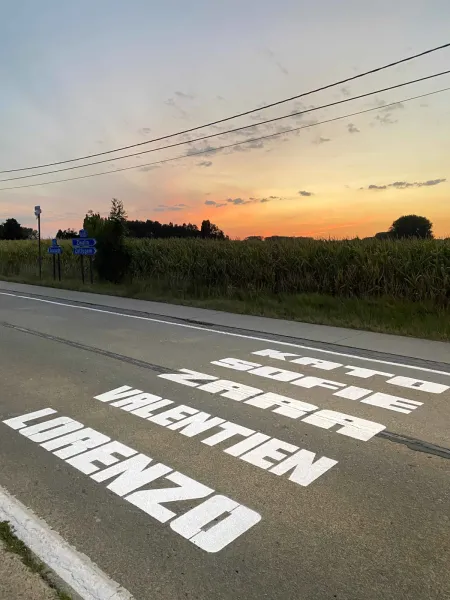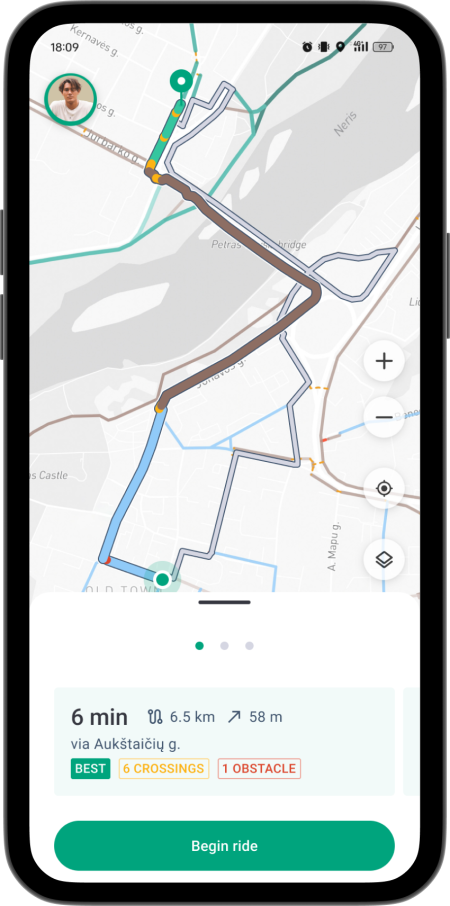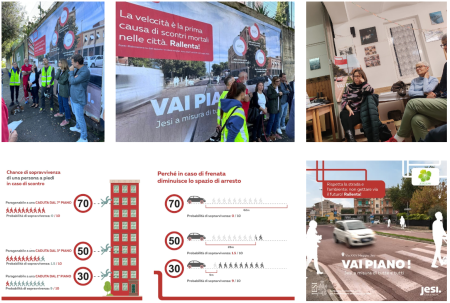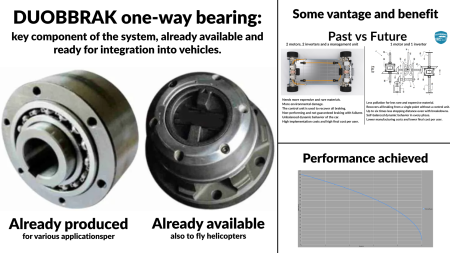Create awareness

Thursday, May 15, 2025
There is a large number of safe driving courses for drivers on polygons in the Czech Republic. Drivers are taught how to react when driving in poor conditions, while being in the safe environment of a closed polygon area. It prepares them for safer driving in traffic. However, these courses are only available to drivers without significant medical limitations.
In the Czech Republic people with hearing impairment or physical disabilities are also able to drive. Until recently, there were no safe driving courses for people with disabilities and therefore they did not have the same training opportunities as drivers without ones. Thus, in regular traffic there is a group of drivers interested in safety education that is not available to them. Because of that they put themselves and those around them at greater risk.
Driving calmly and without stress should be possible for every driver, regardless of the external driving conditions. Safe driving courses allow the driver to experience dangerous situations and then not be afraid of them in regular traffic. These courses should be available to all groups of drivers that are active participants in traffic: including drivers with disabilities, who currently often face hidden barriers just entering driving schools. Platforma VIZE 0, which has been devoted to drivers’ education for a long time, has taken this education gap under its wing by creating the Courses for Drivers with Disabilities. By organising these courses, a database of participants is created. These participants not only actively improve their driving skills but also provide valuable feedback. It helps to expose discriminatory attitudes in the current system of training future and current drivers, such as admission to driving schools etc. The courses then serve as the starting point on the way to developing a new methodology for working with drivers with disabilities: from adjustments in teaching and instructors' approach to recommendations for final exams. The methodology will make life easier not only for those with disabilities but also for instructors in driving schools.
In the Czech Republic people with hearing impairment or physical disabilities are also able to drive. Until recently, there were no safe driving courses for people with disabilities and therefore they did not have the same training opportunities as drivers without ones. Thus, in regular traffic there is a group of drivers interested in safety education that is not available to them. Because of that they put themselves and those around them at greater risk.
Driving calmly and without stress should be possible for every driver, regardless of the external driving conditions. Safe driving courses allow the driver to experience dangerous situations and then not be afraid of them in regular traffic. These courses should be available to all groups of drivers that are active participants in traffic: including drivers with disabilities, who currently often face hidden barriers just entering driving schools. Platforma VIZE 0, which has been devoted to drivers’ education for a long time, has taken this education gap under its wing by creating the Courses for Drivers with Disabilities. By organising these courses, a database of participants is created. These participants not only actively improve their driving skills but also provide valuable feedback. It helps to expose discriminatory attitudes in the current system of training future and current drivers, such as admission to driving schools etc. The courses then serve as the starting point on the way to developing a new methodology for working with drivers with disabilities: from adjustments in teaching and instructors' approach to recommendations for final exams. The methodology will make life easier not only for those with disabilities but also for instructors in driving schools.

Monday, May 12, 2025
Road safety awareness comes at a very late age, usually when studying for the driving license. We sought to impact at an earlier age of development, when children are still learning and molding basic and essential values for life.
Through this initiative, we allow kids to explore and reflect on key values like safety, care for the environment and respect for others.
All in all, they will probably be future drivers.
Through this initiative, we allow kids to explore and reflect on key values like safety, care for the environment and respect for others.
All in all, they will probably be future drivers.

Friday, May 9, 2025
By 2050, the percentage of people over 50 in the European Union will be almost 50% of the total population. According to UN estimates, the average life expectancy will increase from the current 68 to 76 years, and in highly developed countries from 77 to 83 years. This group of road users will therefore grow, which consequently means that the statistical probability of crashes involving a senior will also increase.
According to data from the Motor Transport Institute in Poland, the main problems of Seniors leading to a crash are related to:
• undivided attention,
• incorrect perception of road situations,
• narrowing of the field of vision, poor contrast sensitivity and distance assessment,
• extended time of performing maneuvers, reaction time, eye-hand coordination.
The main causes of road crashes in Poland are:
• among Seniors driving cars - failure to give way at an intersection,
• among Seniors cycling - uncontrolled entry into a part of the roadway not designated for cyclists (pedestrian crossing),
• among Seniors walking - entering the roadway directly in front of an oncoming vehicle (often from behind an obstacle).
The social costs of all road incidents in Poland in 2022 amounted to PLN 52 billion, including the costs of road crashes PLN 37.9 billion and the costs of road collisions PLN 14.1 billion. In 2021, these costs were lower. The share of seniors in the cost statistics accounted for 9% of all road crashes and amounted to PLN 3.4 billion. The lower cost in the case of seniors results from the adopted assumptions regarding productivity and projected life expectancy. However, it should be borne in mind that society is "aging" and the number of seniors will increase. The life expectancy of seniors will also increase. These factors will undoubtedly affect changes in the proportions of the annual costs of road crashes in Poland.
According to data from the Motor Transport Institute in Poland, the main problems of Seniors leading to a crash are related to:
• undivided attention,
• incorrect perception of road situations,
• narrowing of the field of vision, poor contrast sensitivity and distance assessment,
• extended time of performing maneuvers, reaction time, eye-hand coordination.
The main causes of road crashes in Poland are:
• among Seniors driving cars - failure to give way at an intersection,
• among Seniors cycling - uncontrolled entry into a part of the roadway not designated for cyclists (pedestrian crossing),
• among Seniors walking - entering the roadway directly in front of an oncoming vehicle (often from behind an obstacle).
The social costs of all road incidents in Poland in 2022 amounted to PLN 52 billion, including the costs of road crashes PLN 37.9 billion and the costs of road collisions PLN 14.1 billion. In 2021, these costs were lower. The share of seniors in the cost statistics accounted for 9% of all road crashes and amounted to PLN 3.4 billion. The lower cost in the case of seniors results from the adopted assumptions regarding productivity and projected life expectancy. However, it should be borne in mind that society is "aging" and the number of seniors will increase. The life expectancy of seniors will also increase. These factors will undoubtedly affect changes in the proportions of the annual costs of road crashes in Poland.

Tuesday, May 6, 2025
Alcohol-related accidents are one of the most preventable yet persistent causes of road fatalities. In Europe, they represent a significant share of traffic deaths, especially in nightlife settings such as bars, clubs, festivals, and sports events. These are environments where individuals often underestimate their level of intoxication and decide to drive without assessing their fitness. Most of these venues lack accessible and non-stigmatizing tools to help individuals evaluate their condition before driving. Traditional campaigns are costly and not scalable, leaving a gap in continuous on-site prevention. Fline addresses this challenge with the FlineBox, an interactive, self-service breathalyzer designed for high-risk environments. It enables real-time testing, encourages behavioral change, and collects anonymized data to support targeted public safety strategies. This initiative offers a scalable and sustainable solution to bridge the gap between awareness and action, directly reducing risk where it occurs.

Friday, May 2, 2025
Veilig Over is een initiatief dat ernaar streeft voetgangers veilig te laten oversteken en dat bovendien iedereen toestaat om ook zélf aan te duiden waar er nood is aan een veilige oversteekplaats, via een onlineplatform veiligover.be. Samen oversteken veilig maken, dat is de ambitie van ‘Veilig Over’. Dit doen we met een unieke samenwerking met lokale en regionale overheden & burgerparticipatie en citizen sciene & wetenschappelijke evaluatie (met Vias institute). Dit alles met als resultaat: de concrete verwezenlijking van een veilige oversteekplaats op het terrein!

Thursday, April 24, 2025
We've developed an app with a safe map for cycling. Routes are made according to quality of infrastructure (user, company gathered and municipalities info), hazards on the road.
Users can report bad infrastructure or good things about it and routes are calculated accordingly.
Users can report bad infrastructure or good things about it and routes are calculated accordingly.

Wednesday, April 16, 2025
Una delle sfide principali riguarda una cultura radicata che privilegia l'uso dell'automobile, scoraggiando l'adozione di mezzi pubblici e di trasporti alternativi. Questo comportamento si riflette in un mancato rispetto delle normative del codice della strada. Inoltre, c'è una scarsa attenzione verso la protezione degli utenti più vulnerabili, come pedoni e ciclisti. Questo atteggiamento compromette la vivibilità della città, che viene vissuta più come un luogo di transito che come uno spazio di incontro e socializzazione.

Monday, April 14, 2025
We looked for solutions on how to improve the current situation regarding the availability of alcohol, its use and the prevention of drunk driving among young people in our and surrounding municipalities.

Thursday, April 10, 2025
Road safety in Europe and worldwide is still tragically compromised by a high number of accidents and avoidable loss of human lives.
This is compounded by the worrying frequency of vehicle recalls for brake problems, with over 3 million units affected in just two years (ANSA data), a symptom of an intrinsic vulnerability in current systems.
The dependence on rare materials in traditional braking systems and new technologies not only creates economic instability but also generates significant geopolitical implications.
Furthermore, there remains a lack of a reliable and universal mechanical solution capable of improving braking and ensuring safety in the event of failure.
These challenges highlight the urgent need for innovative solutions like DUOBBRAK, capable of overcoming the limitations of current systems, despite the resistance, and mostly the indifference, encountered in promoting it within the industry, accelerators, and public and private institutions
This is compounded by the worrying frequency of vehicle recalls for brake problems, with over 3 million units affected in just two years (ANSA data), a symptom of an intrinsic vulnerability in current systems.
The dependence on rare materials in traditional braking systems and new technologies not only creates economic instability but also generates significant geopolitical implications.
Furthermore, there remains a lack of a reliable and universal mechanical solution capable of improving braking and ensuring safety in the event of failure.
These challenges highlight the urgent need for innovative solutions like DUOBBRAK, capable of overcoming the limitations of current systems, despite the resistance, and mostly the indifference, encountered in promoting it within the industry, accelerators, and public and private institutions

Wednesday, April 9, 2025
The C•AUTO project addresses several persistent and emerging road safety challenges, particularly within urban environments. One of the main problems we focus on is excessive vehicle speed in sensitive areas such as school zones, hospitals, pedestrian crossings, and high-risk intersections. Despite existing signage and infrastructure, speeding remains a leading cause of accidents, particularly those involving vulnerable road users like children, the elderly, and cyclists.
Another key issue is the lack of adaptive and proactive tools to manage traffic behavior in real-time. Current solutions often react after incidents occur, rather than preventing them. C•AUTO proposes an innovative approach through the deployment of intelligent electric vehicles that function as mobile “City Safety Cars.” These vehicles travel at regulated speeds and use predictive data to position themselves strategically in urban areas with higher accident risk.
Furthermore, C•AUTO tackles the challenge of building a shared safety culture. It aims to influence driver behavior through presence, not punishment—creating an environment of passive regulation, education, and visual deterrence rather than relying solely on fines or enforcement.
By addressing both infrastructural gaps and behavioral aspects, C•AUTO contributes to achieving the Vision Zero goal of eliminating fatalities and serious injuries on our roads.
Another key issue is the lack of adaptive and proactive tools to manage traffic behavior in real-time. Current solutions often react after incidents occur, rather than preventing them. C•AUTO proposes an innovative approach through the deployment of intelligent electric vehicles that function as mobile “City Safety Cars.” These vehicles travel at regulated speeds and use predictive data to position themselves strategically in urban areas with higher accident risk.
Furthermore, C•AUTO tackles the challenge of building a shared safety culture. It aims to influence driver behavior through presence, not punishment—creating an environment of passive regulation, education, and visual deterrence rather than relying solely on fines or enforcement.
By addressing both infrastructural gaps and behavioral aspects, C•AUTO contributes to achieving the Vision Zero goal of eliminating fatalities and serious injuries on our roads.